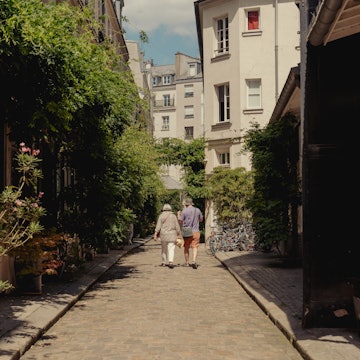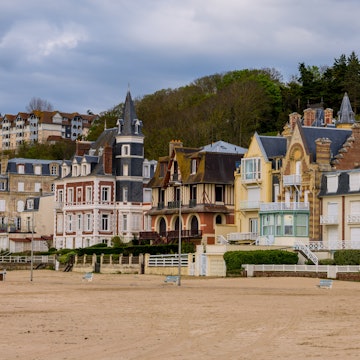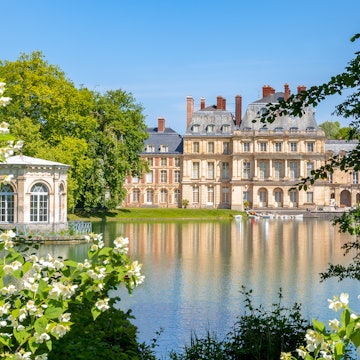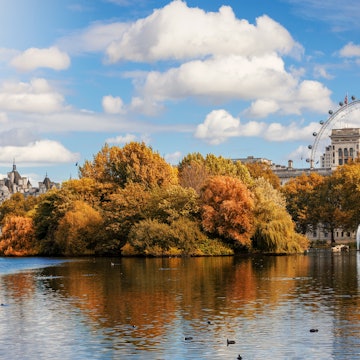

Opéra de Vichy. Andrei Antipov/Shutterstock
Vichy, in the center of France, is one of the 11 Great Spa Towns of Europe which in July 2021 were jointly awarded a UNESCO World Heritage Label. Just like its counterparts, Vichy is a town where people come for spa treatments, seeking curative and therapeutic effects from its natural mineral spring waters, which you will have drunk if you’ve ever bought a bottle of Vichy water.
Others just come for a day or two to soak in some 19th-century vibes with the architecture, take in some shows at the spectacular yellow and ivory art nouveau opera house, enjoy gourmet meals, and be sporty on and along the majestic Allier, one of Western Europe’s few remaining wild rivers.

What is Vichy known for?
But Vichy has also been trying hard for the past 80 years to shake off a darker image, at least in the eyes of the French. At its height in the late 19th and early 20th centuries Vichy had up to 250 hotels that could welcome more than 100,000 clients a year. This accommodation capacity, the presence of a modern telephone exchange, and its geographical position south of the German Nazi line of occupation were why the town was chosen by the collaborationist, contested government of France as its capital from July 1940 to August 1944.
Today Vichy is a thriving small town (population: 26,000) which continues to restore its elegant 19th-century heritage and care for its waters, already appreciated by the Romans. The first thermal establishment was built and promenades designed to accommodate Louis XV’s eight daughters (born between 1727 and 1737) enabling them to cool off after the warm baths, digest the water they’d drunk and take therapeutic walks.
But it was the Bonapartes who really pushed Vichy’s development. In 1812, at the request of his mother, Letitia, Napoleon I paid for more promenades to be built and fountains to be installed thereby creating the Parc des Sources, which links the water sources and the baths and forms the town’s backbone.
His nephew Napoleon III (1808–1873), who came five times to treat his renal colic, continued the work. For his first two visits in 1861 and 1862 the city authorities put the Villa Strauss at his disposal. In thanks, he decreed an urban development plan with a railway station, a new street layout and a casino, where visitors sedately played cards and board-games!
In 1863 architect Jean Lefaure built him a “chalet” (more of a small mansion!), the “Marie-Louise”, but it faced the boulevard and the emperor wanted greater privacy so had Lefaure build him two others facing the river Allier: one for him, one for his long-suffering wife the Empress Eugenie. These two chalets at 107 and 108 boulevard des États-Unis bear a discreet crown and initials “N” and “E” above their respective doors. They, and the four others in a row next to them, are privately owned so you can’t visit them but you get a very good view of them from the riverside park.
Lefaure also designed eight identical villas along the rue Alquié for the imperial guard, but after Napoleon ceased visiting Vichy these villas were sold. Each new owner modified their villa so n°21 remains the closest to the original design.

When should I go to Vichy?
May to October are the nicest months. Bring or rent your sumptuous crinolines, parasols and top hats if visiting in mid-June for the annual Napoleon III festivities when the town slides 150 years back to the hey-day of imperial gaiety. From September to May you can enjoy a wide variety of shows at the sumptuous art deco opera house and shop...even on Sundays because, since 1906, this is one of the very few towns in France where shops are permitted to open on that day.
How long should I spend in Vichy?
If you’re coming to just visit the town then you’ll see most of the sights in two days. You can also book up to five days of health and beauty treatments and intersperse these with cultural activities. If you come for a thermal cure prescribed by a doctor then the minimal stay is 21 days.
The Vichy cure is indicated for the treatment of metabolic diseases such as type 2 diabetes (non-insulin-dependent), high cholesterol and/or triglycerides and/or uric acid levels. It also treats digestive disorders and food allergies.
It is also prescribed by doctors for the treatment of arthritis, tendinitis, back problems; the after-effects of trauma (sprains, dislocations, fractures), fibromyalgia, algodystrophy and orthopedic surgery; osteoporosis; gout and inflammatory rheumatism.
Vichy's medically prescribed spa treatments always last three weeks and include drinking the thermal waters, having mud poultices applied, taking thermal steam baths and showers and receiving underwater massages from a physiotherapist. The patient is seen three times by a doctor and has a multidisciplinary team at hand including nutritionists and psychologists.

Where should I go for a spa treatment?
In 2025 while the historical Dômes thermal establishment, with its spectacular Moorish dome, is closed for renovations, the Vichy Célestins Thermal Spa is the only establishment in town that offers Vichy mineral water wellness and beauty treatments. The Callou Thermal Spa, which is where medically-prescribed treatments are given, also offers a five-day mini-cure, no prescription needed.
Can my thermal cure be paid for by my health insurance provider?
If you are a resident of an EU country, Iceland, Liechtenstein, Norway, Switzerland or the UK and the health insurance system in your country of residence covers thermal cures, then your health insurance provider may cover you on condition that a thermal cure cannot be undertaken in your own country within a reasonable delay given your health. Contact your health insurance provider for personalized instructions.
Is it easy to get to and around Vichy?
Vichy lies 360km (224 miles) south of Paris. Come by train because you really don’t need a car in the town, which fans out from the train station to the Allier river just 1km (0.6 miles) away. Everything is walkable. There are nine trains a day from Paris (average travel time 3½ hours) and 10 a day from Lyon (2 hours), which is 160km (99 miles) southeast of Vichy. The journey from Paris costs €22.50–70 (US$26–80) and from Lyon, €18–35 (US$20–40).
If you’ve come by car, park it in the underground La Poste car park (€8/US$9 for 24 hours).

Top things to do in and around Vichy
Taste the famous Vichy waters at Hall des Sources
First go to the Hall des Sources designed by Lucien Woog and Charles Lecoeur at the northern end of the Parc des Sources where you can freely taste water (or fill your bottle) from five of the nine sources. I’ve tasted all five: Chomel – whose minerals are used to make the famous Vichy-État lozenges – is good for indigestion; Grande Grille, which needs to be drunk in homeopathic doses, can have surprising effects on the digestive system; Hôpital, which is very sulfurous; Célestins, the saltiest of all (actually bicarbonate of soda); and Lucas…well, let’s say I prefer tap water!
Promenade in Parc des Sources
The 280m-long (918ft) eastern and western edges of the Parc des Sources are both lined with a covered wrought-iron walkway built in 1901–02 by Émile Robert to allow ladies and gentlemen to promenade, protected from sun and rain. Imitate them to reach the southern end of the park where you’ll find the Grand Casino and Opera.
Tour Vichy's iconic Grand Casino
The Grand Casino is Vichy’s iconic building. Inaugurated on July 2nd, 1865 it was designed by Charles Badger in a classical style, its facade decorated by caryatids representing the four seasons. It had a theater, games rooms, a gentlemen’s reading room, a ladies’ conversation room and a vast ballroom. But it quickly became too small so in 1903 a new art nouveau theater was added, the old one transformed into a huge games room. But after the tragedy of WWII, the casino fell into disrepair until 1988 when the town bought the building to turn it into a conference center. The art deco ornamentation inside has just been renovated so it’s worth booking a tour to see it.

Find the source of Célestins water
A little over 400m (1312ft) south of the casino, (go via the rue Hubert Colombier, once a private road with its extraordinary mix of neo-Flemish, art nouveau and neo-Gothic buildings all built between 1895 and 1905 for short-term rentals), have a look at the Célestins source, now protected behind marble and glass under an elegant, elliptical, 18th-century style pavilion designed by architect Lucien Woog. The water from this source is the one that’s bottled and sold the world over.
See the colors within Notre Dame des Malades
Then walk 100m (328ft) further south to Notre Dame des Malades church (aka Saint Blaise) built between 1925 and 1956. Don’t be put off by the austere reinforced concrete exterior. Inside you’ll find an explosion of colors from the slender lapis lazuli columns to the strong red, blues and greens of the stained glass windows via the shimmering gold of the mosaics.
Turning back north between the park and the river admire the flamboyant early 20th-century homes built for wealthy patrons on the boulevard des États-Unis, the rue de Belgique and the boulevard de Russie.

My favorite thing to do in Vichy
I really enjoy visiting the art nouveau Opéra de Vichy, which opened in March 1903 and is the only one in Europe with a yellow, ivory and white color scheme. With seating for 1400 people, it is still today the biggest pre-modern opera house in France outside Paris. I love the two white peacocks painted over the proscenium arch and the jewel-studded heads painted on the ceiling between the arches. I recommend taking a guided tour as this is where you’ll also learn about Vichy’s role in WWII.
How much money do I need to visit Vichy?
You won't spend much if you’re just visiting the town, but expect to part with considerable sums if you want some wellness and beauty treatments thrown in!
Cup of coffee: €2 (US$2.30)
Beer: €3.50 (US$4)
Three-course meal: €35 (US$40)
Night at a hotel: €85–234 per night (US$97–266)
Four half-day beauty treatments at the Célestins Spa & Thermal Hotel: €855 (US$973)
Detox at Célestins: €930 (US$1058)
There are about 20 hotels in the vicinity of the Parc des Sources to choose from. Top of the range is the Maison Decoret (€234/US$266 a night for two). But perfectly comfortable is Le Patio, which will only set you back €85 (US$97) for two. But for a real 19th-century vibe try the pavilion of Le Chalet Impérial Clermont-Tonnerre (one of those “chalets” mentioned above) for just €95 (US$108).
For something more medieval you can stay for €210 (US$239) in the moat-surrounded Chateau de la Mothe, just a half-hour’s drive west of Vichy.
The choice for food is vast, from the Maison Decoret’s 1-star Michelin restaurant (€135/US$154 or so for dinner) to a three-course meal for as little as €28 (US$32) at the Michelin-recommended Les Caudalies.
















